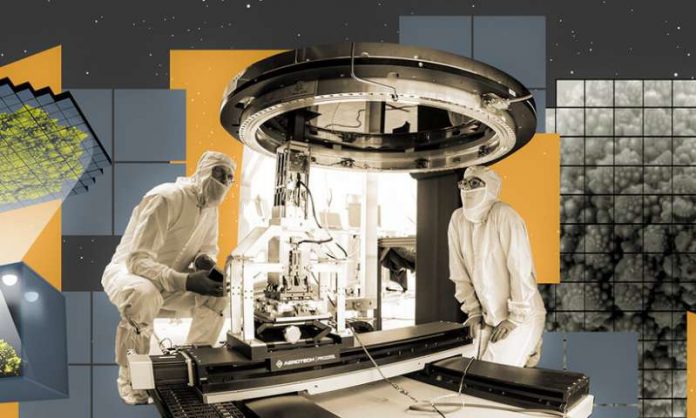Crews at the Department of Energy’s SLAC National Accelerator Laboratory have taken the first 3,200-megapixel digital photos—the largest ever taken in a single shot—with an extraordinary array of imaging sensors that will become the heart and soul of the future camera of Vera C. Rubin Observatory.
The images are so large that it would take 378 4K ultra-high-definition TV screens to display one of them in full size, and their resolution is so high that you could see a golf ball from about 15 miles away. These and other properties will soon drive unprecedented astrophysical research.
Next, the sensor array will be integrated into the world’s largest digital camera, currently under construction at SLAC. Once installed at Rubin Observatory in Chile, the camera will produce panoramic images of the complete Southern sky—one panorama every few nights for 10 years. Its data will feed into the Rubin Observatory Legacy Survey of Space and Time (LSST)—a catalog of more galaxies than there are living people on Earth and of the motions of countless astrophysical objects. Using the LSST Camera, the observatory will create the largest astronomical movie of all time and shed light on some of the biggest mysteries of the universe, including dark matter and dark energy.
The first images taken with the sensors were a test for the camera’s focal plane, whose assembly was completed at SLAC in January.
“This is a huge milestone for us,” said Vincent Riot, LSST Camera project manager from DOE’s Lawrence Livermore National Laboratory. “The focal plane will produce the images for the LSST, so it’s the capable and sensitive eye of the Rubin Observatory.”
SLAC’s Steven Kahn, director of the observatory, said, “This achievement is among the most significant of the entire Rubin Observatory Project. The completion of the LSST Camera focal plane and its successful tests is a huge victory by the camera team that will enable Rubin Observatory to deliver next-generation astronomical science.”
In a way, the focal plane is similar to the imaging sensor of a digital consumer camera or the camera in a cell phone: It captures light emitted from or reflected by an object and converts it into electrical signals that are used to produce a digital image. But the LSST Camera focal plane is much more sophisticated. In fact, it contains 189 individual sensors, or charge-coupled devices (CCDs), that each bring 16 megapixels to the table—about the same number as the imaging sensors of most modern digital cameras.
Sets of nine CCDs and their supporting electronics were assembled into square units, called “science rafts,” at DOE’s Brookhaven National Laboratory and shipped to SLAC. There, the camera team inserted 21 of them, plus an additional four specialty rafts not used for imaging, into a grid that holds them in place.
The focal plane has some truly extraordinary properties. Not only does it contain a whopping 3.2 billion pixels, but its pixels are also very small—about 10 microns wide—and the focal plane itself is extremely flat, varying by no more than a tenth of the width of a human hair. This allows the camera to produce sharp images in very high resolution. At more than 2 feet wide, the focal plane is enormous compared to the 1.4-inch-wide imaging sensor of a full-frame consumer camera and large enough to capture a portion of the sky about the size of 40 full moons. Finally, the whole telescope is designed in such a way that the imaging sensors will be able to spot objects 100 million times dimmer than those visible to the naked eye—a sensitivity that would let you see a candle from thousands of miles away.
“These specifications are just astounding,” said Steven Ritz, project scientist for the LSST Camera at the University of California, Santa Cruz. “These unique features will enable the Rubin Observatory’s ambitious science program.”
Over 10 years, the camera will collect images of about 20 billion galaxies. “These data will improve our knowledge of how galaxies have evolved over time and will let us test our models of dark matter and dark energy more deeply and precisely than ever,” Ritz said. “The observatory will be a wonderful facility for a broad range of science—from detailed studies of our solar system to studies of faraway objects toward the edge of the visible universe.”








